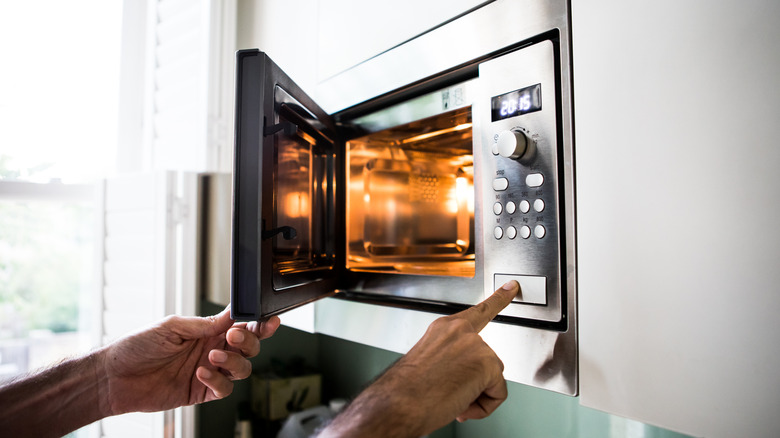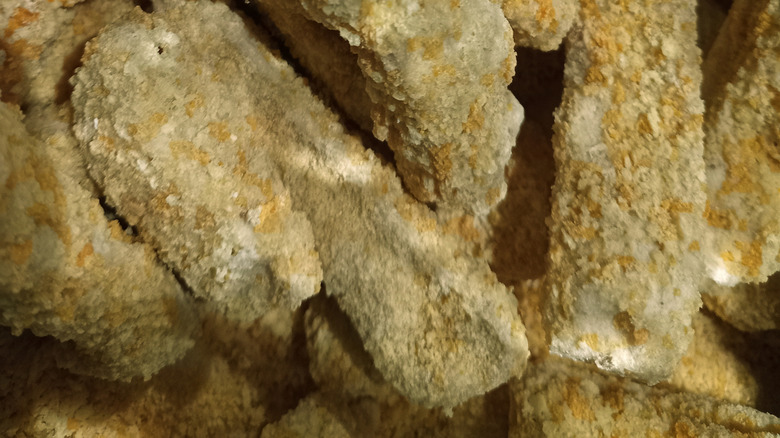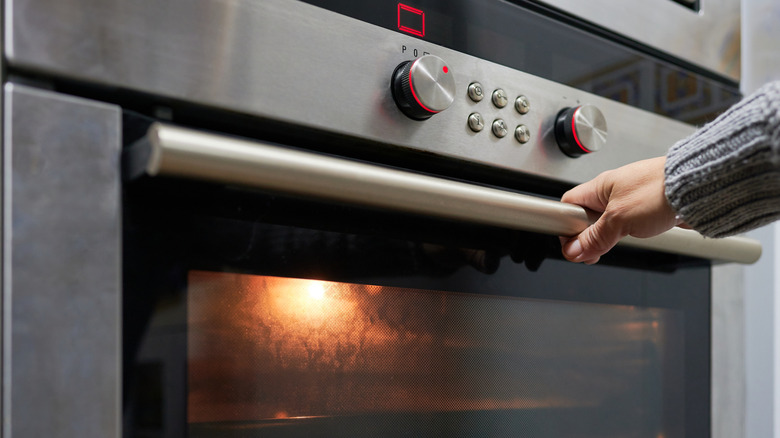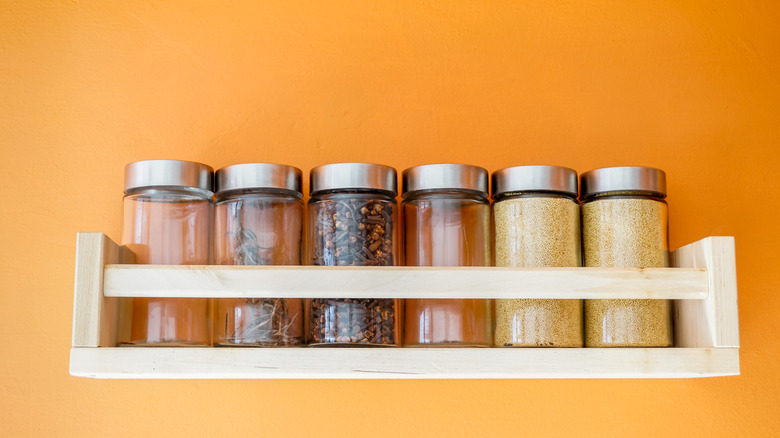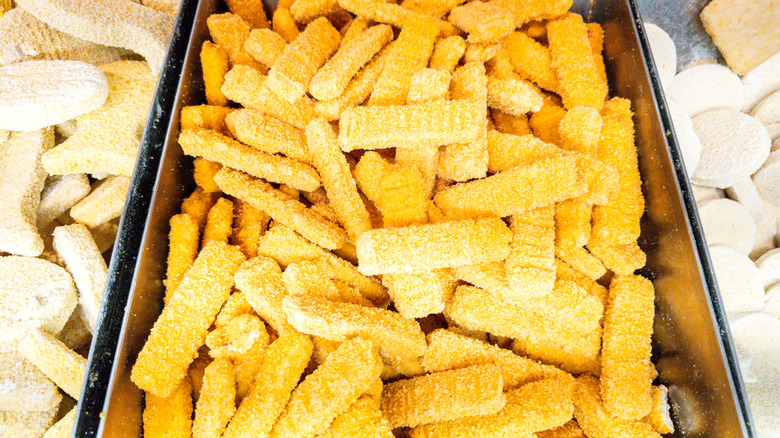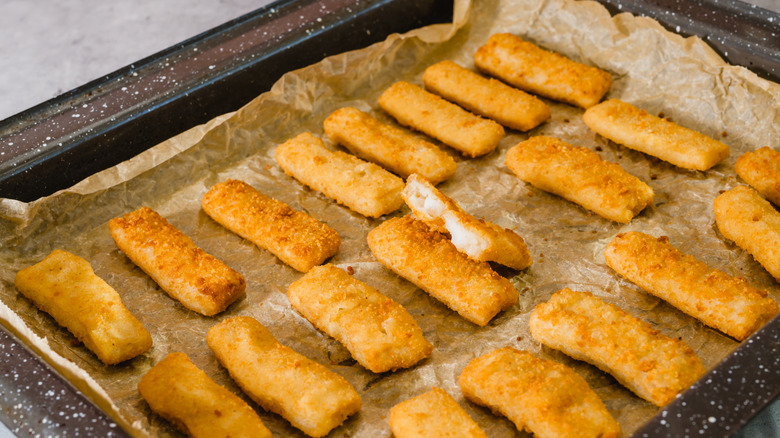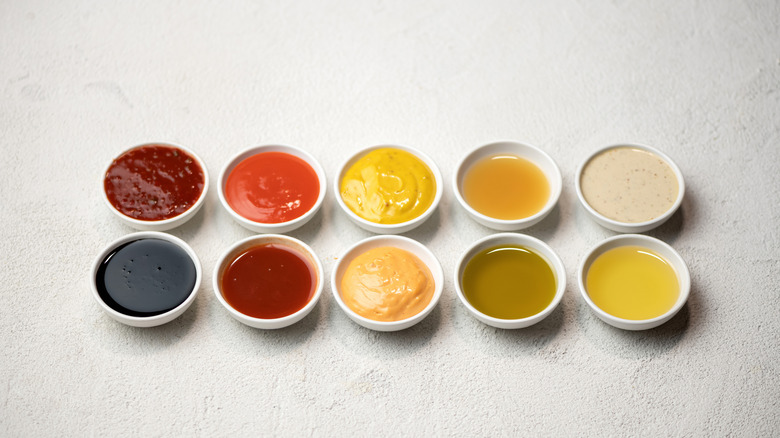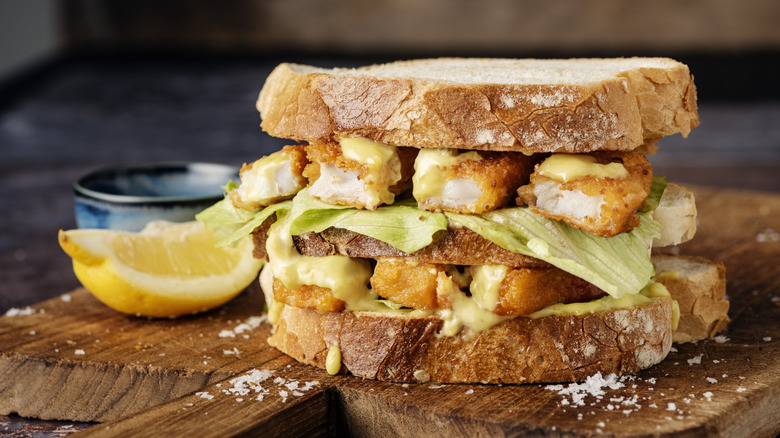Mistakes Everyone Makes When Cooking Frozen Fish Sticks
Frozen fish sticks might instantly make you think of elementary school cafeteria lunches or after-school snacks. But this traditionally kid-friendly treat isn't only for little ones. Coated in delicious bread crumbs and made with deliciously mild, flaky, white fish, frozen fish sticks are the perfect weeknight meal for all ages when you're in a pinch for time — or are looking for something equally easy, fast, and delicious.
But when not prepped properly, these frozen morsels can leave a bad taste in your mouth both literally and figuratively. Instead of blindly following the manufacturer directions (which can result in a mushy, soggy mess of fish) avoid a few of the most common pitfalls that cause your fish sticks to fall flat when it comes to both flavor and texture. Discover the most common mistakes when making frozen fish sticks and how to avoid them next time you're ready to nosh on this savory snack.
Cooking in the microwave
Despite what your frozen fish stick directions may say on the back of the box, never heat your fish sticks in the microwave. This cooking method — while not unsafe — will more than likely lead to an unappealing, awful texture.
Microwaves work by heating water inside of food, exciting the molecules and warming them up. This creates steam that warms the food from the inside out. The steam that is released while frozen fish sticks cook, however, has another side effect: it makes the exterior breading ultra soggy. Conventional ovens cook food from the outside in to achieve a crispy texture. The microwave, however, works in reverse. While fast and convenient, this doesn't deliver the best texture for any breaded products — and especially for frozen fish sticks. Opt instead for other cooking methods like the oven or air fryer. You can even deep fry them if you're feeling adventurous.
Thawing in advance
Thawing some frozen foods in advance is a smart move that shortens the cooking time — but frozen fish sticks should stay in the freezer until you're ready to roll. Though certain, fatty fishes like salmon or swordfish taste best when thawed before cooking, the leaner, white fish typically used for fish sticks is versatile enough to cook from frozen without ruining the texture.
Thawing and refreezing fish breaks down the cell walls, which is the reason frozen fish becomes mushy. The more times the fish thaws and refreezes, the worse and worse the problem becomes. To keep the integrity of your fish sticks as intact as possible, keep the fish frozen until ready to eat (especially since there's no telling how many times they've thawed slightly and refrozen during manufacturing, shipping, and stocking on shelves).
The thawing process not only ruins the fish's texture, but it can also lead to soggy breading. The ice crystals in frozen fish turn to water as they thaw, releasing steam as the fish sticks cook. This makes breading soggy too, and it can cause the exterior coating to fall off the fish sticks completely. Long story short: Don't thaw your frozen fish sticks unless specifically directed by the manufacturer.
Avoiding the air fryer
For the ultimate crunchy, crispy fish sticks, the air fryer will quickly become your best friend. Though some frozen variations don't have manufacturer-provided air frying instructions, it's an amazing alternative to the oven or skillet to get that deep-fried effect — without all of the oil.
Air fryers are a kitchen appliance that circulates hot air around the interior (similar to a convection oven). The hot air crisps up all the food exterior without any excess oil or other fats. This gives you unbeatable texture and also has the advantage of making traditionally fried foods a little bit healthier.
The air fryer seems to be a beloved fish stick cooking method for many, not only for the improved texture but also the ease and speed. Just cook them for about 10 minutes at 400 degrees Fahrenheit, flipping once halfway through. Once done, you'll have golden-brown, perfectly crispy fish sticks that are ready to eat.
Not preheating your oven
Preheating the oven — though it may sometimes seem unnecessary — is a manufacturer recommendation for a reason. Heating your oven to the cooking temperature before adding your food ensures that the food cooks as evenly as possible. It's especially important for frozen items to prevent them from thawing before they begin to cook.
Putting your frozen fish sticks in a non-preheated oven will cause them to thaw as the oven heats up, but before they begin to actually cook. This has the same effect as if you thawed them on the counter before cooking; the ice in the frozen fish will turn into a puddle of water, making the fish sticks' breaded exterior soggy. Instead, when the frozen fish sticks are put into an already-hot oven, they'll begin to cook immediately. This helps to prevent that dreaded sogginess. Not only that, but preheating your oven also helps you produce a more consistent result. You'll get similar batches of fish sticks every time so you can always rely on a delicious, satisfying meal.
Using the wrong oil
When frying frozen fish sticks, choosing the right oil is vital to getting a delicious taste and maximum crunch. Most fish — fresh or frozen — should be fried using oil with a high smoke point. While canola oil is a common choice because of its neutral taste, you could also use peanut or coconut oil to infuse additional flavor.
No matter which oil you choose, you have to fry the fish at the proper temperature to make sure the inside is cooked before the exterior burns. Heat the oil to about 375 degrees Fahrenheit to help ensure the fish cooks evenly on both the inside and outside. This high heat cooks frozen fish sticks quickly, all without giving the breading an unappealing, overly oily flavor. Just be sure not to cook them for more than a few minutes — doing so is a common mistake when making fish sticks that can negatively impact both the texture and flavor.
Skipping your own seasoning
Like many prepared or frozen foods, some store-bought frozen fish sticks are lacking in the flavor department. Luckily, it's an easy problem to solve. Adding your own seasoning to your fish before cooking can amplify the flavor and give this premade meal your own personal twist.
The different flavor combinations you can use to enhance frozen fish sticks are nearly endless. From taco-inspired spices like paprika, cayenne, and cumin to lemon pepper to Old Bay, the sky is the limit. No matter your chosen cooking method, season up your frozen fish sticks before you begin by dusting the exterior with your preferred spice blend. You can also experiment with liquid add-ons like hot sauce or chili crisp. Don't forget to also salt to taste once your fish sticks come out of the oven, air fryer, or frying pan — taste a sample before serving to get the levels just right.
Overcrowding your pan or tray
There's one major cooking faux pas that can make your frozen fish sticks a mushy mess: overcrowding your pan. While it might seem like cooking everything in one batch will save time, it actually traps moisture and leads to uneven cooking.
As your fish sticks heat up in the oven, they release water. On an uncrowded pan, that water heats up quickly and turns to steam, which helps cook the fish as it evaporates. When the pan is too crowded, however, that water gets trapped and doesn't turn to steam. Instead, it gets stuck in the pan and, essentially, boils the fish sticks as they bake.
But it's not just the cooking time itself that's the problem — it's the cool-down period, too. A crowded pan cools down faster, causing the fish sticks to release even more moisture. This can also make the breaded exterior mushy, so crowding the pan is truly a lose-lose situation. Keep the fish sticks evenly spaced — and make multiple batches if necessary — for the best, crispy texture.
Forgetting to flip
One of the best parts of frozen meals is the ease and convenience. And while it may be tempting to toss your fish sticks into the oven and forget them until they're cooked, there's one vital step you don't want to skip. Taking the time to flip the fish sticks at least once will help them cook more evenly to deliver a more consistent, golden-brown color.
This crucial step is so important that many manufacturers include it right on the box in their directions. Even if it's not explicitly spelled out, flipping the fish sticks helps ensure that both sides not only get cooked consistently throughout but also get equally crispy on all sides. In addition to flipping the fish sticks, you should also consider rotating your pan to account for any uneven heat distribution in your oven. Though these steps aren't necessary to make sure the fish is completely cooked and safe to eat, they'll make your fish sticks taste that much better once they come out of the oven.
Overcooking the fish
Most frozen fish sticks are not already cooked, so it's important to ensure the fish itself is heated through for food safety. But you have to walk a fine line to ensure you don't overcook the fish, or you might end up with a tough, dry meal instead. When cooked too long, the fish will lose a lot of its moisture and take on an almost rubbery texture. Though still technically edible, overcooked fish sticks are definitely not palatable. It can also cause the exterior breading to burn, creating a bitter taste.
If you're unsure where to start, following the manufacturer's instructions should help you achieve the right level of doneness. You can also gauge doneness by the texture of the fish; it should flake easily and look opaque. When in doubt, always check the internal temperature to ensure it's 145 degrees Fahrenheit. Once they hit that benchmark, you can take your fish sticks out of the oven, air fryer, or frying pan and dig in.
Forgetting the citrus
If you decide to forgo adding your own seasoning to frozen fish sticks in the name of simplicity, there's another easy hack to add flavor that's even simpler. Add a squeeze of fresh lemon juice once cooked for add a bright hit of citrus. This common culinary pairing between lemon and fish is so beloved because the acidic flavor of the lemon helps to balance out strong, fishy flavors.
Though lemon is the default citrus to pair with fish, you can also experiment with other citrus fruits to switch it up. The tart, bitter taste of limes or the sweet and slightly tart flavor of oranges also complement fish well and can help to level up your frozen fish sticks without a lot of extra effort. If you're feeling extra fancy, you can also use the zest — or one of the best lemon zest substitutes — from any citrus fruit for a more concentrated hit of flavor (thanks to the outer layer of skin that's loaded with essential oils).
Not switching up the sauce
You can't go wrong with a classic dab of tartar sauce or a dash of ketchup on your frozen fish sticks. But why not expand your horizons beyond these common condiments? Because fish sticks are typically made with mild, white fish and coated in plain panko breadcrumbs, they lend themselves well to a wide range of flavors — and sauces are the perfect way to incorporate them.
Consider infusing Asian flavors into a dipping sauce by mixing with soy sauce, rice vinegar, ginger, scallions, and cilantro. You can also mix in chili oil if you like a hint of spice. An herb aioli with lemon, mustard, dill, chives, mint, and tarragon is a refreshing take on tartar sauce that adds a bright, creamy, and earthy taste to your fish sticks. To keep things even easier, you can use ready-made condiments like malt vinegar, hot sauce, or honey mustard for a ton of flavor with very little effort. Look at some of the most popular condiments from around the world if you need a little inspiration.
Only eating them plain
Fish sticks are the perfect fast finger food — delicious, easy, and affordable. But instead of only eating them as-is, you can find more creative ways to incorporate them into your weekly meal plan. Their mild flavor makes them perfect for use in other recipes as a flaky, frozen fish base.
For your next taco night, whip up a batch of frozen fish sticks to use as your protein. Add a few cooked fish sticks into a tortilla and top with cabbage or coleslaw, a cilantro-lime sauce, avocado slices, and a squeeze of lime juice for simple and delicious fish tacos. You can also add three or four fish sticks into a bun or atop your favorite bread, slather with tartar sauce or mayo, and top with shredded lettuce for a copycat McDonald's Filet-O-Fish sandwich (you can make these with frozen fish fillets, too). Along with these meals, there are countless ways to upgrade store-bought fish sticks — use your imagination.

